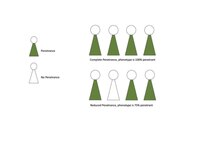
Photo from wikipedia
Hypertrophic cardiomyopathy (HCM) is a monogenic disease with autosomal dominant inheritance. Genotype–phenotype relationships are complex, with variable penetrance even within the same family. The involvement of other modulating genetic and… Click to show full abstract
Hypertrophic cardiomyopathy (HCM) is a monogenic disease with autosomal dominant inheritance. Genotype–phenotype relationships are complex, with variable penetrance even within the same family. The involvement of other modulating genetic and environmental factors is unknown. We aimed to analyze the HCM in monozygotic twins, carriers of the same founder pathogenic variant MYBPC3 p.G263*. The relationship was verified using the PowerPlex 16 HS System kit. Phenotypic differences and environmental differences (overloading conditions, coexistence and location, lifestyle, sport, and intensity) were analyzed. Three pairs of twins genetically identical for all markers and carriers of MYBPC3 G263* were identified. No environmental differences were identified. One of the 89-year-old twins had symptomatic severe obstructive HCM that required septal ablation, while her twin has remained asymptomatic with mild phenotype >80 years. A 49-year-old twin had a severe phenotype of obstructive HCM and pending myectomy, while his twin had a mild asymptomatic phenotype. In the last pair of twins, one presented a much larger left ventricular hypertrophy than his identical twin. In summary, we present three pairs of HCM twin patients sharing not only the genetic cause of the inherited disease but the entire genetic background. Despite identical genetic information and the absence of other known clinical, environmental, or lifestyle differences, the severity of the HCM phenotype is strikingly different. These unexplained differences should prompt the study of other unknown modulating factors, either epigenetic or environmental.
Journal Title: Life
Year Published: 2022
Link to full text (if available)
Share on Social Media: Sign Up to like & get
recommendations!